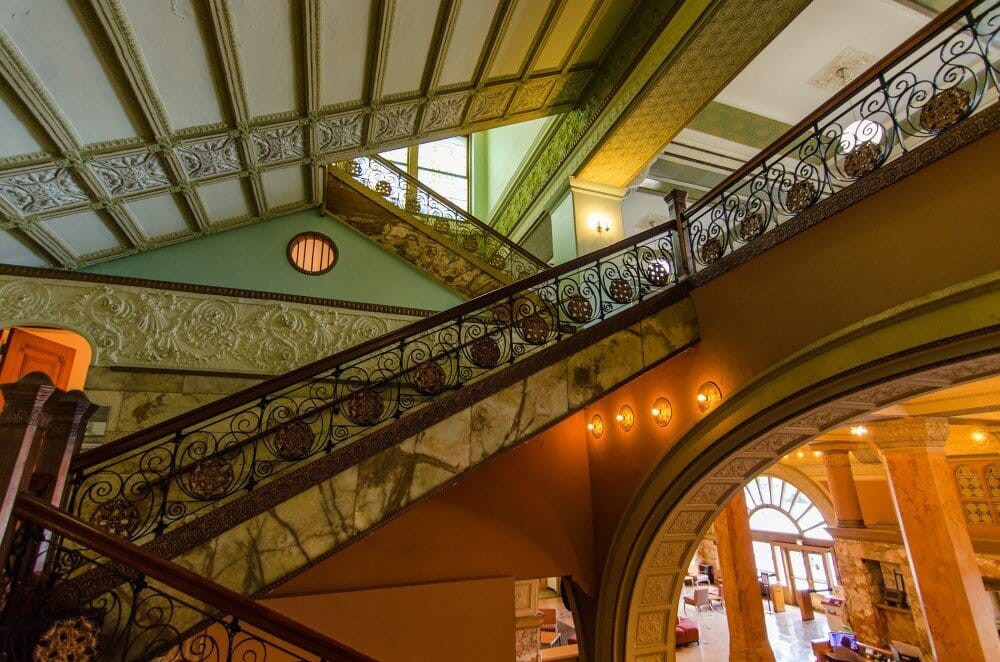

5 Chicago theaters
Chicago is famous for its architecture, but our city is also home to a world-renowned and vibrant theater scene.
Chicago is famous for its architecture, but our city is also home to a world-renowned and vibrant theater scene.
by Emily Koval
From classical Broadway productions to cutting-edge, experimental shows, Chicago’s range of productions is as diverse as it is entertaining. The buildings that house these works of art are just as fascinating as the stories told on their stages and screens. Here are five architecturally significant theaters in Chicago.
1. AUDITORIUM BUILDING
Designed by Adler & Sullivan and completed in 1889, the Auditorium Building is an example of what can happen when business and the arts collide. The building’s developer, Ferdinand Wythe Peck, was a wealthy philanthropist who was committed to making the arts more available to working class Chicagoans. The Auditorium Building is the result of Ferdinand’s vision. He decided to include an income-generating luxury hotel and business offices in the building to keep ticket prices low, making it one of the first mixed-use structures in the city. At the time of its completion, the theater was the largest, tallest, priciest and heaviest building in the world.
2. THE YARD AT CHICAGO SHAKESPEARE
The Chicago Shakespeare Theater (CST) has called Navy Pier home since 1999. The company went on to become one of the largest in the city, hosting approximately 600 performances each year. Its exponential growth created a need for a larger space. Hoping to expand in a cost-effective manner without sacrificing theatrical quality, CST turned to Adrian Smith + Gordon Gill Architecture and theater consultant Charcoalblue to design The Yard at Chicago Shakespeare. The theater is housed under a large white tent that originally covered Navy Pier’s outdoor Skyline Stage. Its interior is unique, with nine movable seating towers that can be placed in several different configurations to fit the individual needs of each production. The theater’s innovative design and technology make it one of the most versatile performance spaces in the world.
3. UPTOWN THEATRE
Located in Chicago’s Uptown neighborhood, the Uptown Theatre was once considered one of the most opulent and gorgeous movie palaces ever built in America. Described as an “acre of seats in a magic city,” the theater was designed by the same architects who were largely responsible for popularizing the idea of a movie palace. Brothers Cornelius Ward Rapp and George Leslie Rapp envisioned the Uptown Theatre as a place for moviegoers to escape from urban life. The focal point of the Spanish Baroque Revival theater was its luxurious, six-story grand lobby built to imitate the palaces of Versailles or St. Petersburg. After the theater suffered major damage when storm drain pipes froze and burst in December 1981, the theater closed its doors. After more than 35 years of vacancy, the city announced in June 2018 plans to restore the Uptown Theater to its former 1925 glory.
4. WRITERS THEATRE
The Writers Theater was founded in 1992 as an experimental theater company that focused on the intimate relationship between actor and audience. Performances were originally held in the back room of a Glencoe bookstore. When the theater’s venue proved much too small for its growing demand, the company called on architecture firm Studio Gang to design a dynamic, modern space that paid homage to the surrounding neighborhood. The building incorporates several nods to the Writers Theater’s past, including bookshelves lining the building’s corridors and recycled bricks from another of the company’s former homes. Unlike the extravagant movie palaces of the 1920s, the theater’s design uses natural materials, an open layout and state-of-the-art engineering to ensure that the performance is the star of the show.
5. DAVIS THEATER
Originally known as the Pershing Theater, Lincoln Square’s Davis Theater is Chicago’s longest running movie theater. In 1999, the city almost lost the 100-year-old Art Deco theater when the owners listed it for sale. When Lincoln Square residents learned of the impending demolition, they rallied around the theater and saved the historic building. Clearly beloved by the community, the Davis Theater is also a unique piece of architecture. Designed by Walter Ahlschlager, the theater’s terracotta exterior features classical and Roman-inspired elements while its sign and lobby contain distinctive Art Deco and Art Moderne details. According to the National Register of Historic Places, the combination of the different architectural styles make the Davis Theater an “unusual survivor among historic Chicago movie theaters.”